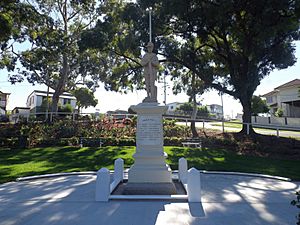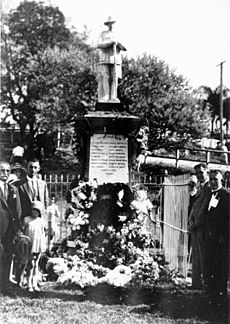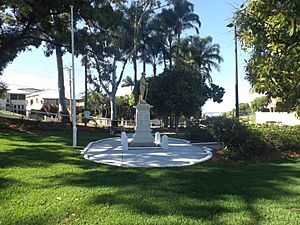Manly War Memorial facts for kids
Quick facts for kids Manly War Memorial |
|
|---|---|

Memorial in 2015
|
|
| Location | 184 Carlton Terrace, Manly, City of Brisbane, Queensland, Australia |
| Design period | 1919 – 1930s (interwar period) |
| Built | 1920–1921 |
| Official name: Manly War Memorial, Ferguson Street Reserve, Manly Dam, Soldiers Memorial Park | |
| Type | state heritage (built) |
| Designated | 21 August 1992 |
| Reference no. | 600249 |
| Significant period | 1920–(social) |
| Significant components | trees/plantings, pathway/walkway, garden furniture/seating, flagpole/flagstaff, memorial surrounds/railings, memorial – soldier statue |
| Lua error in Module:Location_map at line 420: attempt to index field 'wikibase' (a nil value). | |
The Manly War Memorial is a special monument in Manly, Australia. It's located at 184 Carlton Terrace. This memorial was built between 1920 and 1921. It's also known by other names like Ferguson Street Reserve and Soldiers Memorial Park. Because of its importance, it was added to the Queensland Heritage Register on August 21, 1992.
Contents
History of the Memorial
The Manly War Memorial was officially revealed to the public on March 5, 1921. A local politician named Walter Henry Barnes did the honours. We don't know who designed it or who carved the stone.
The memorial was first made from brown sandstone and dark granite. It featured a statue of a soldier made from white marble. This monument was built to remember 16 local men from Manly who died during the First World War.
The land where the park stands today was bought in 1860. Over the years, it was planned for different uses, including a water reserve. The memorial was put up around 1920. However, the land wasn't officially made a park until 1937.
The park was once called Manly Memorial Park. In 1990, it was renamed after Richard Russell. He was an important early citizen and businessman in Manly.
Sadly, the soldier statue on the memorial was damaged several times over the years. In 1992, it was pulled down and its head broke off. A new concrete statue was put in its place in 2007. But the original marble statue, which people thought was lost, was found again in 2013!
Why War Memorials Are Important
Before the First World War, Australia didn't have many public monuments. But after the war, many memorials were built. They became our first national monuments. They showed how much the war affected Australia. About 60,000 Australians died, which was a huge number for a country of only 4 million people.
Even before the war ended, people started building memorials. They were a way for the nation to show its sadness. For many, these memorials were like sacred graves. They were places to remember soldiers whose bodies were buried far away in Europe and the Middle East. The word "cenotaph" means "empty tomb." It was often used for war memorials.
Australian war memorials are special because they remember everyone who served, not just those who died. Australians were proud that their army was made up of volunteers. These memorials show how communities were involved in the war.
These memorials also show the skills of local stonemasons and artists. In Queensland, statues of soldiers, often called "diggers," were very popular. These statues were seen to represent the "ANZAC spirit" and the qualities of an ideal Australian soldier: loyalty, courage, and youth.
What the Memorial Looks Like
The First World War Memorial is in a small park at the end of Manly's main shopping street. It sits in a special oval-shaped area within the park. This area has paths, garden seats, hedges, and tall trees.
The memorial is surrounded by a low border with square posts at each corner. It stands on a round concrete base.
The main part of the memorial, called the pedestal, is made of painted sandstone. It has a simple design.
The bottom section has smooth steps. Above this, there's a section with slightly sloping sides. On the front, there's a marble plaque with the names of the local men who died in the First World War. The word MANLY is carved below. On the side facing west, there's another marble plaque with names of local men who died in the Second World War.
Why It's a Heritage Site
The Manly War Memorial was added to the Queensland Heritage Register on August 21, 1992. This means it's considered very important for several reasons:
- It shows Queensland's history: War memorials help us understand how Queensland's history unfolded. They show how much Australian patriotism and nationalism grew, especially after the First World War.
- It shows what memorials are like: This memorial is a great example of a monument built to remember a big historical event. It uses special materials and designs to do this.
- It's beautiful: The memorial and its park are a landmark in Manly. They make the town look nicer.
- It's important to the community: The memorial is very important to the local community. It helps them remember a major historical event and honor those who served.



